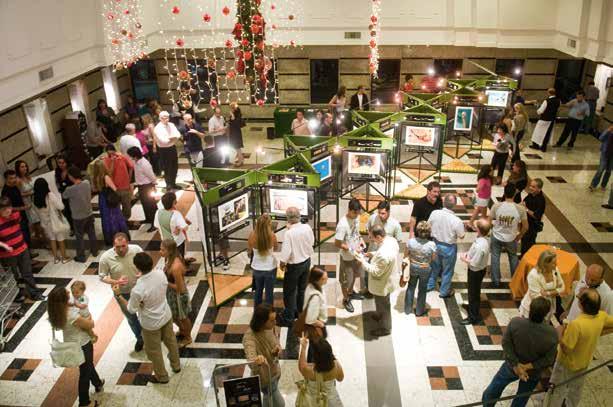
2 minute read
THE GAME
TURMA REUNIDA PARA FESTEJAR A OBRA DE AMPLIAÇÃO DA SEDE
EXPOSIÇÃO FOTOGRÁFICA DE MARCELO RUSCHEL
Advertisement
THE WHOLE GROUP GATHERED TO CELEBRATE THE WORK DONE TO EXPAND THE FACILITIES
MARCELO RUSCHEL’S PHOTO EXHIBITION a ter ideias para salvar WimBelemDon. “Acredito que esse movimento deu força para o Marcelo e a Lu correrem atrás e fazerem de tudo para não deixar o projeto fechar.”

Era preciso fazer alguma coisa. Aumentar a captação. Surgiu a ideia de uma exposição. Um dos apoiadores, CEO da Câmara de Comércio Americana (Amcham) e ex-tenista profissional, Leandro Rosa, foi o primeiro a sugerir: fotos de tênis. “Por mais que eu conseguisse a autorização dos atletas, não queria usar a imagem de tenistas, pois isso poderia parecer autopromoção”, alega Marcelo. Então ficou definido que seriam usadas apenas fotos artísticas. Assim, em dezembro de 2008 era lançada a mostra “Tênis/Arte: Marcelo Ruschel – Exposição 25 anos de Fotografia”, no Shopping Bourbon Country, que reunia 50 imagens captadas em quadras do mundo inteiro ao longo da sua carreira de fotógrafo.
As fotos foram doadas ao projeto. A venda delas – e de outros produtos relacionados às imagens feitos especialmente para a exposição, como calendário de mesa, de parede, cartões postais, revista – rendeu quase R$ 15 mil e garantiria a continuidade do trabalho. Além disso, houve doações diretas e foram alavancados novos apoiadores. “EU E A LU FIZEMOS UM PACTO DE DOAR NOSSO SANGUE E NÃO DEIXAR FECHAR. Se a exposição desse certo, tentaríamos de todas as maneiras buscar capacitações sobre o terceiro setor, nos profissionalizar.”
Esse era o caminho a partir daquele momento: entender o funcionamento de uma ONG e profissionalizar o trabalho desenvolvido no WimBelemDon. O jogo ganhava novos contornos. Era ganhar ou ganhar. Era preciso entrar na quadra dos grandes, jogar como profissional.
Mudan A T Cnica
Marcelo ficou sabendo de um projeto-piloto lançado pela ONG Parceiros Voluntários em parceria com o Banco Interamericano de Desenvolvimento (BID) e patrocínio da Petrobras. Era o curso “Educando para a Transparência”, sobre transparência e gestão de contas para o terceiro setor, movement gave Marcelo and Lu the strength to put in the work and do whatever it took to keep the project from closing.”
Something had to be done to increase the funds raised. The idea for an exhibition emerged. One of the supporters, CEO of the American Chamber of Commerce (Amcham) and former professional tennis player, Leandro Rosa, was the first to make a suggestion: tennis photos. “Even though I could get authorisation from the players, I didn’t want to use their image because it could look like selfpromotion”, Marcelo claims. It was then agreed that only artistic photos would be used. Thus, in December 2008 the “Tennis/Art: Marcelo Ruschel – 25 Years of Photography” exhibition opened at Shopping Bourbon Country, displaying 50 images captured on tennis courts all over the world throughout his career as a photographer. The photos were donated to the project. Their sale – and of other products related to the images especially made for the exhibition, such as desktop calendar, wall calendar, postcards, magazine – generated almost R$ 15,000 to guarantee continuity for the work. In addition, there were also direct donations and new sponsors were found. “LU AND I TOOK A BLOOD OATH NOT TO LET IT CLOSE. If the exhibition went well, we would try everything to get trained and qualified in the third sector”.
This was the pathway from that moment on: understanding how an NGO should operate and make the WimBelemDon work fully professional. The rules of the game were being re-defined. It was winning or winning. They needed to enter the court with the greatest and play like professionals.
Technical Change
Marcelo heard about a pilot project launched by the Parceiros Voluntários NGO, in partnership with the Inter-American Development Bank (IBD) and sponsored by Petrobras. This was the “Educating for Transparency” course, about transparency and accounts management for the third sector, which included the project “Developing










